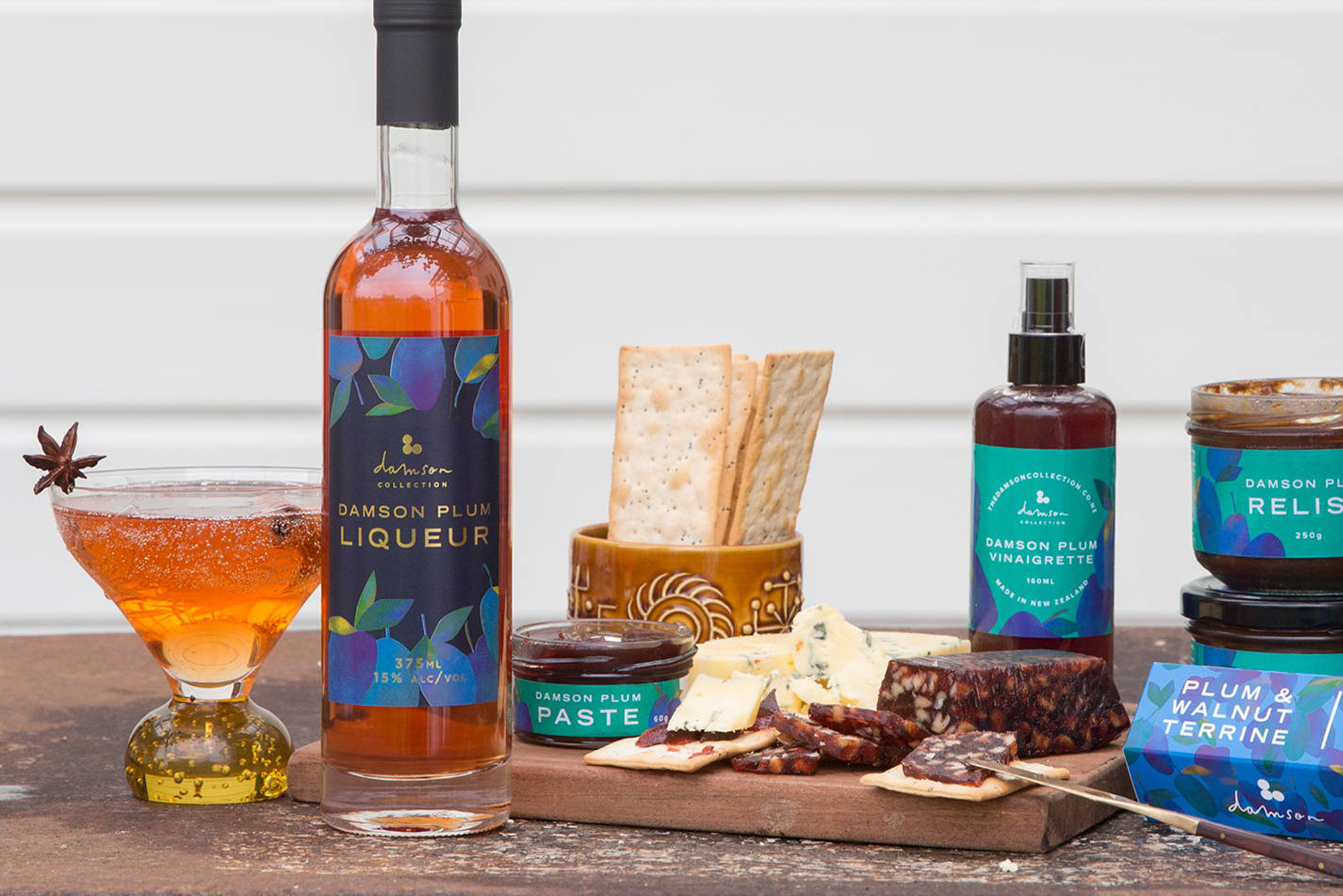From an in-demand photographer to macaron maven, and then onto weaving magic – and plenty of praise – with damson plums for the Damson Collection’s jams, relishes and award-winning liqueur, Fiona’s nose for business is as keen as her palate for things that taste damn good.
A note from Mel: Fiona and I had a Zoom chat for well over an hour. I absolutely love her story, her vibrant and warm personality, her great sense of humour, and her determination to make sure as many people as possible know how amazing the damson plum is.
Hi Fiona, thanks for joining us. So tell us, where did it all start for you?
“Okay so, I’ve been a commercial and editorial photographer for 25 years and I ended up with the Damson Collection through another business that I’ve got, called Macarons.co.nz. But I needed something that would roll without me. My photography business had always been about me, people book me, they don’t want the next person, they don’t want my assistant, they want to pay for me. And so I bought a macaron business for almost next to nothing. That little business had really only supplied one or two cafés and did a farmer’s market at the weekend. I turned that into a really good viable business to the point where we did a $65,000 order for Christmas, just macarons. I hand-piped all those little suckers myself!”
How did you go from photography to buying a food business – do you love baking?
“I hate cooking! I just hate it. But, what I realised was that I was really good at was building relationships, I was really good at the story and I have a really good palate for food. So, I had this business and did really well with it, and then I moved to Hawke’s Bay. How I got Damson is, when I was in Auckland making macarons, the orchardist’s wife and the main cook for Damson, had come to me and said, “would you please put our damson powder in your macrons”, so there’s the connection. My best seller at the time was a salted caramel, but when I started making damson, it completely overtook sales of everything; people loved the tartness against the sweetness of the macaron. When I got to Hawke’s Bay, I started baking out of their kitchen, because they had a production kitchen, which was registered. As I grew to know her, I realised that she didn’t want to be in the business, so I bought it based on overseas trends that I had seen for gin and the low-alcohol spirits. For me, I bought it purely to get a supply contract for the damson plums.”
When you took on Damson, what it was like running the business in the early days?
“When the couple had the business, they did all the sales, marketing, distribution themselves. I was advised, because I had quite a busy photography schedule and also because I thought the power was in the numbers rather than me, to put the distribution with a distribution company. It had 12 sales reps around the country and it was a local place – I would never, ever, do that again. I went from a $250,000 turnover, right down to $60,000 in about 18 months. You know, it’s my own fault; at the time I had a terminal mother at home and so my focus wasn’t really on the business. So, then I took [the distribution] back and we got the sales up again. We’ve done more in sales in first quarter than we had over the couple of years with the sales team, so now it’s just a question of building it up again.”
How did it go for you, actually producing the product? Was it a big mindset shift, going from making macarons to now having gin, liqueur and jams?
“When I got the business, obviously I got all the IP for the jams and all of that sort of thing. I have a contract cook and she is amazing. She does all my cooking for me, so all I have to organise is logistics, you know, the jars and getting the pulp from the chillers and all that, so everything is there [for her]. I didn’t have to worry about [making the product], I just had to worry about getting the product out again, building the relationships with some of the people we were selling to and carrying on like that.”
How did you turn the damson liqueur that existed when you bought the company, into the premium product it is today?
“I contacted several distilleries and they all went ‘Oh my god, we just don’t have the time to do it’. Then I came across a lovely smaller distillery that does a lot of export product. They’re German, they’re master distillers, and they basically took this crazy idea that I had to make something that was world class, which is what it’s ended up being, and they helped me work on it. We went through several iterations; the first one was made completely differently to the way we make it now and, even though it tastes similar, it’s much more refined, and smooth, and beautiful. It’s a much nicer product. So we did a couple of 200-bottle batches, and then we doubled to a 400-bottle batch, now we’ve done two pallets – that’s 5,000 bottles – and I’ve gone, ‘f*#k!’ It’s kind of like half a house sitting in booze!”
*note from Sundae; this sounds like a dream.
But it’s award-winning booze! How did it feel when Damson Plum Liqueur took top honours at the World Liqueur Awards earlier this year?
“With awards, I do think it’s a lottery, I honestly do. We’ve picked up a bronze recently, and we’ve done one competition in the UK and we didn’t win anything. But when I did the World Liqueur Awards, it’s a very targeted and specific niche market, so the people tasting it obviously understand how the product can be used. I entered it, and I knew it was really good, but I didn’t realise it was that good. It’s that whole thing, until you win a medal or get recognised by other people in your industry, you don’t actually understand what you’ve got.”
What other products are you planning to add to the Damson Collection?
“We’re doing some research on our freeze-dried powder to work out the nutritional value in it. There’s been studies done overseas between New Zealand and Australian blackcurrants, for example, and those grown in the UK. We’ve [New Zealand and Australia] got different, but similar, climatic conditions because of our UV. The black currants that are grown in the southern hemisphere have 10 times the efficacy of those grown in the northern hemisphere. It’s a really big opportunity for a big story around a product. You can imagine it in your smoothies and your baking and protein powders. They say it’s because the skin on our fruit has to be tougher to cope with the UV light and so it keeps all the goodies on the inside. It could be soil as well, but we’re just starting to do that research. We’ve also got a botanical to do a 40 percent-odd damson gin. It sort of smells like plum and marzipan because the stones in the damson give off that marzipan taste and smell. I’m going to look at probably crowd-funding that so that people become invested in it.”
Licensing and distribution can be a tangle of red tape, especially in the food and drink space – how is your plan for global domination going and how do you find overseas distributors?
“You know, the UK, Canada and Australia understand the Damson brand because of the large numbers of expats. I was looking at [a Canadian agent’s] website, and he was a Scot and everything just kind of all fell into place. I put the business on something called Beverage Trade Network, which is kind of like a [online] portal for makers and sellers and buyers and distributors, a global one. I started trawling through. I sent email after email, and I had my top three that I really wanted and [the Canadian agent] was my top top. I couldn’t get hold of him, I emailed and I rang and I stalked him on LinkedIn. I sent a text: ‘I really want to work with you, but I understand if you don’t, could you please just…’ He’d been on holiday! I actually felt like a stalker. We had a good giggle about that. I was so focused on wanting that particular agent for a variety of reasons, it just became my target. Nothing’s going to happen until next year, because the Canadian market is all licensing trusts, so they basically buy [licences] for the whole state. So they will say, ‘yes, you can sell your product into that whole area and we will have that through all of our stores’.”
What about distribution in Australia?
“I’m having trouble finding someone in Australia. I’ve started on my alcohol licence, but it’s $10,000 for me to go through the whole legal stuff, get an ABN, get my licence. It’s just expensive.”
What happens now with Canada?
“I’m going to send over my wholesale pricing without excise tax. He’s got spreadsheets that the government gives him and it spits through all the numbers. It’s totally transparent, which I really like. Then we work out a price it will sit in. There’s a few complications because the liqueur is in a 375ml bottle, which is really good for the UK, New Zealand, Australian markets; Canada likes a 750ml, and the [United] States likes 700ml, so everybody has a different size. He did say that the 375ml bottles, he reckons he could get over the line. It might be that the first pallet, or two or three or four or whatever, go as the 375ml and then we bottle specifically for the Canadian market, so it’s a long-term game.”
So it’s different rules for different schools?
“With the States, I’m going through all the FDA stuff with labelling the jams and relishes. Australia and New Zealand have the same food labels, we work on the same nutritional information panel and the compliance is exactly the same. But in the States, it’s so particular, it’s a 140-odd page handbook – it tells you, this is the label and this is the proportion of space for your brand… – everything is different!”
In a world without COVID restrictions, your international distribution sorted and the new Damson products ready to roll, what does that look like?
“I’d like to have the powder and products as a completely new brand. We’ll be launching the gin, producing more liqueur and increasing distribution. I’m really excited for what 2021 will bring.”
Follow Damson Collection on Instagram and Facebook and order online at thedamsoncollection.co.nz

